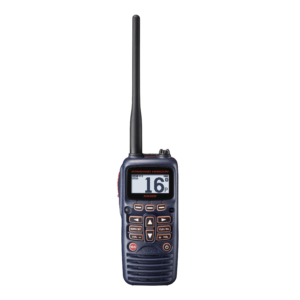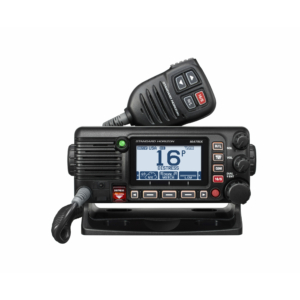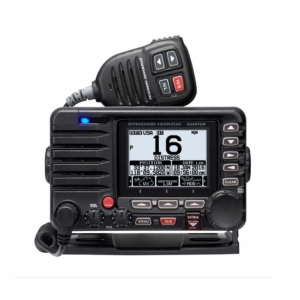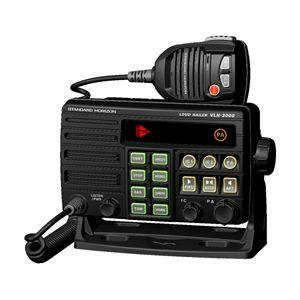The nice weather is here and there are more questions/requests than usual about VHF marine radios. We had an idea to ask an expert to help us compile a list of the most frequently asked questions with answers. Luckily, we didn't have to go far, because the managing director of our company - Anico Ltd - Joe Dévényi (HA0LC), a sailing enthusiast and amateur radio operator. We asked him about radiocommunication on the rivers, on Lake Balaton and on the seas.

On what frequency can we use our marine radio?
Yes, you can monitor several channels at the same time, depending on what is built into the radio. With DW (dual watch), in addition to the channel set on the radio, the radio will also monitor the CH16 general calling channel every few seconds. In standby, all vessels must monitor CH16. Some units can also be set to TW (triple watch) mode, which allows three channels to be watched. If traffic is detected on any one of them, scanning will stop there and the communication will be heard.
Can we monitor multiple frequencies at the same time?
Yes, you can monitor several channels at the same time, depending on what is built into the radio. With DW (dual watch), in addition to the channel set on the radio, the radio will also monitor the CH16 general calling channel every few seconds. In standby, all vessels must monitor CH16. Some units can also be set to TW (triple watch) mode, which allows three channels to be watched. If traffic is detected on any one of them, scanning will stop there and the communication will be heard.
What is the range of these devices? Does the antenna affect this range?
The range is affected by the height of the antenna and the output power of the radio transmitter. With a handheld radio in a boat or life raft it is about 5nm (nm = nautical miles). If a rescue helicopter is sent, it is about 25 nm. With a built-in VHF boat radio on a motor yacht: about 30nm. With built-in VHF boat radio on a sailing yacht: approx. 50nm. With built-in MF (medium wave) radio: 200-400 nm. With built-in HF (short wave) radio: from 400 to several thousand nautical miles depending on season, time of day and frequency. With INMARSAT C satellite equipment: up to +/-70 degrees latitude unlimited.
The range is significantly increased if the transceiver antenna of the shore station is installed at high altitude, e.g. on a mountain top. This is the case, for example, in the Adriatic Sea, where there is VHF coverage over the entire water surface.
Is it advisable to buy a mobile or hand-held device for boats on Lake Balaton and international waters?
Only VHF equipment may be purchased for inland waters. For pleasure crafts (e.g. motorboats, small sailing boats), you can buy a built-in set or a simple handheld set. On inland waterways, DSC is not compulsory, and there is no such system used, so it is unnecessary to spend money on it. The built-in devices definitely include DSC, but you can't use it in inland waters.
For marine use, buy a built-in radio that has DSC (not all older, second hand ones have it), a NMEA0183 or NMEA2000 compatible bus system (to communicate with other on-board electronics), a built-in or external GPS receiver, and maybe a Bluetooth or wired remote control for convenient radio communication from the cockpit. The icing on the cake is if you have a built-in AIS receiver (automatic identification system, mandatory on large vessels, recommended for pleasure craft). This will allow you to see on the chart plotter the large vessels in the area and their most important information (name, MMSI number, call sign, size, course, speed, etc.) up to a distance of about 30-50 nm, displaying of dangerous approaches can be turned on, etc.

Do you need a license from the National Media and Info communications Authority to use a marine radio?
Yes. By law, and in all cases. In case of built-in radios, when MMSI or ATIS code is required, this is unavoidable. If someone only needs a handheld radio to listen to the instructions on regattas, permission is not usually applied. We are not aware of any fines for this. Ask your national authority about it!
What is an MMSI number?
The MMSI (maritime mobile service identity) is used to identify the vessel's VHF/MF/HF radio, other GMDSS equipment (EPIRB, INMARSAT C). The format is: MID xxx xxx, where MID is the country identifier (Hungarian MID=243) and xxx xxx is the unique identifier of the vessel's GMDSS equipment. Every vessel can have only one MMSI number. The MMSI number is issued by the communication authority of the country in where the vessel is registered. The MMSI number is registered into an international database and the whole world will know the name, type, registration, etc. of the vessel.
MMSI number is automatically transmitted by the marine radio when:
- we initiating a MAYDAY, SAFETY or URGENCY selective call with DSC
- when making a ROUTINE call (selectively calling another vessel or shore station) with DSC
- if there is an AIS transponder on the vessel, it also gives the MMSI number and identifies the other vessel or shore station
- if there is a distress situation and we drop the EPIRB buoy into the water, it will also transmit the position signals to the satellites togethr with MMSI number
MMSI is not used in inland waters, only at sea. THIS NUMBER MUST BE PROGRAMMED INTO THE DSC-EQUIPPED DEVICE IN ORDER FOR THE DEVICE'S DSC SERVICES TO WORK.
How to get an MMSI ID?
If you already have a valid registration for the vessel, you must also apply for a radio license for the vessel from the communications authority of the country where you are registered. In Hungary, this is the NMHH mentioned above. They issue the radio license, which includes the call sign and the MMSI number.
How to program the MMSI number into the radio, or how to reprogram it if you buy a second-hand marine radio?
When you buy a new radio and your radio has a DSC call function (all built-in radios and the more expensive handheld radios) you can enter the MMSI number for the first time. If, for any reason, the MMSI number changes, it can only be changed by software, which requires a programming cable. This can be done by a radio technician or a specialist from the company that sold you the radio. In exceptional cases, the software and the prg cable can also be purchased.

What to know about using digital selective calling?
Selective calling is done by the DSC of the radio. in the case of a quick distress call, when there is no time to set it in the menu, an undesignated DSC MAYDAY call will be issued by continuously pressing the DSC button and will be received by surrounding vessels and shore stations. Only issue such a distress call if there is a problem on the vessel that seriously endangers the lives of the crew and cannot be resolved without outside assistance. For example, you have a fire and cannot put it out, you have sprung a leak and are sinking, you need to abandon ship quickly and escape to the lifeboat, etc. You should know that by making this call you have given up your ship!!!!!!! Drifting, permanent engine shutdown, etc. is not MAYDAY situation for example yet, until you are dangerously close to the cliff or other source of danger and have no other option to save the crew and yourself.
In international waters, communication may be in the local language of the country and in English. Local sailors use their own language. If you need any assistance or need to contact another vessel, check in at the port or VTS, you can do so in English. You can also communicate with your friends on another boat on a working channel in English.
You can make an URGENCY call (e.g. your engine has broken down and you need a tow, your mast is broken, your boat is out of steerage and you need a tow, someone on board is sick and you need medical assistance, etc.) In some cases, you will be charged for the help. You can make a SAFETY call when you have detected something dangerous to navigation that needs to be shared with other vessels in the area and the shore station. E.g.: a drifting log or container, a buoy or light beacon bulb burnt out or missing, out of its charted location, unexpected hazardous weather, fog, etc. You start the above with a DSC call and then you have to verbally explain the situation. The procedure of the call is well described in the manual. You can initiate a ROUTINE call when you want to call a particular vessel, group of vessels or shore station. To do this you need to know the MMSI number to call, which you can either know, read from the chart plotter (AIS) or look it up in the GMDSS manual/pilot book. After the DSC call you start the verbal communication.
What does the ATIS code signify?
While the MMSI number is used at sea, the ATIS code is used in inland waters in EU, but especially on large rivers. ATIS = Automatic Transmitter Identification System. The unique identification code is transmitted by vessels at the end of each transmission period. This is how coastal stations and other vessels can identify you. Like the MMSI code, it is issued by the communication authority together with the radio license. More information here.
What language is used for communication in international waters?
In international waters, communication may be in the local language of the country and in English. Local sailors use their own language. If you need any assistance or need to contact another vessel, check in at the port or VTS, you can do so in English. You can also communicate with your friends on another boat on a working channel in English.

Can the devices be used for LMR?
In theory, yes, but you need to know that the device operates on shipping channels. It is possible to program other VHF channels into some devices so that they can be used in that system. But it's also useful if you take a handheld radio to the beach for shopping or a pub and use it to keep in touch with the boat.
Who should use a chart plotter?
Recommended mainly for use on sea vessels. You will need to buy a digital nautical chart. The chart plotter connects to other electronic devices and sensors such as GPS, wind, depth, speed, water temperature transmitters, AIS signals, radar images, engine diagnostic sensors, power system status, electronic compasses, etc. Modern chart plotters are multifunctional. Navigational chart, radar image, wind instrument, seabed topography, autopilot etc.
How to use the fog horn for its intended purpose?
As the name suggests, it is particularly useful in fog. You can use the horn to give Morse signals. Failing that, in fog, you should have someone sit at the bow of the boat and blow the horn with their mouth, or make any conspicuous sound (flapping of lids, banging of horn, etc.). Most foghorns have a built-in sound set. In addition, on large vessels it also functions as a loudspeaker. The bridge can thus give instructions or information through the loudspeakers.
Marine channel assignment:
| VHF CH |
Simplex/ |
Use of channel | VHF CH |
Simplex/ |
Use of channel |
| 01 | D | Free to use | 60 | D | Free to use |
| 02 | D | Free to use | 61 | D | Free to use |
| 03 | D | Free to use | 62 | D | Free to use |
| 04 | D | Free to use | 63 | D | Free to use |
| 05 | D | Free to use | 64 | D | Free to use |
| 06 | S |
Boat-to-Boat & SAR Boat - Aircraft |
65 | D | Free to use |
| 07 | D | Free to use | 66 | D | Free to use |
| 08 | S | Boat-to-Boat | 67 | S |
Boat-to-Boat & |
| 09 | S | Boat-to-Boat | 68 | S | Port operations |
| 10 | S |
Boat-to-Boat & |
69 | S | Boat-to-Boat |
| 11 | S | Port operations | 70 | S | DSC channel, for automatic data transmission only |
| 12 | S | Port operations | 71 | S | Port operations |
| 13 | S | 72 | S | Boat-to-Boat | |
| 14 | S | Port operations | 73 | S |
Boat-to-Boat & |
| 15 | S |
On-deck communication (max. power: |
74 | S | Port operations |
| 16 | S | Distress, urgency, security and routine calls | 75 | S |
Reserved for navigation-related communication |
| 17 | S |
On-deck communication (max. power:1 Watt) |
76 | S |
Reserved for navigation-related communication |
| 18 | D | Free to use | 77 | S | Boat-to-Boat |
| 19 | D | Free to use | 78 | D | Free to use |
| 20 | D | Free to use | 79 | D | Free to use |
| 21 | D | Free to use | 80 | D | Free to use |
| 22 | D | Free to use | 81 | D | Free to use |
| 23 | D | Free to use | 82 | D | Free to use |
| 24 | D | Free to use | 83 | D | Free to use |
| 25 | D | Free to use | 84 | D | Free to use |
| 26 | D | Free to use | 85 | D | Free to use |
| 27 | D | Free to use | 86 | D | Free to use |
| 28 | D | Free to use | 87 | S | Port operations |
| 88 | S | Port operations |
Channels used at Lake Balaton:
VHF10. 156,500MHz Tihany ferries /Bahart/
VHF15. 156,750MHz Channel to be used for on-deck communication
VHF16. 156,800MHz International channel reserved for distress and general calls
VHF18. 156,900MHz Channel used for Balaton regattas in the Mid and Western basin
VHF20 157,000MHz Eastern Basin Meteorological and official information channel
VHF22. 157,100MHz Meteorological and official (authorities) information channel
VHF71. 156,525MHz Port-to-boat communication channel
VHF77. 156,875MHz Boat-to-Boat communication channel
At Lake Balaton, a storm warning is in operation from 1 April to 31 September each year, when weather information is also available on marine channels.
You can reach the Rescue Coordination Centre of the Balaton Lifeguards on VHF emergency channel 16 in case of emergency. But they also directly broadcast the periodic NAVINFO-BALATON VHF information service, which can be heard between 15 May and 15 September on VHF 22 (157.100MHz) and VHF 28 (157.400MHz). VHF channel 22 is for the Western Basin and VHF channel 28 for the Eastern Basin.
In addition to the weather report, Balaton Navinfo also provides information about programs and events on Lake Balaton. Broadcast times are 8:30, 12:30 and 17:30 on VHF channel 22 in the Western Basin and 8:35, 12:35 and 17:35 on VHF channel 28 in the Eastern Basin.
















